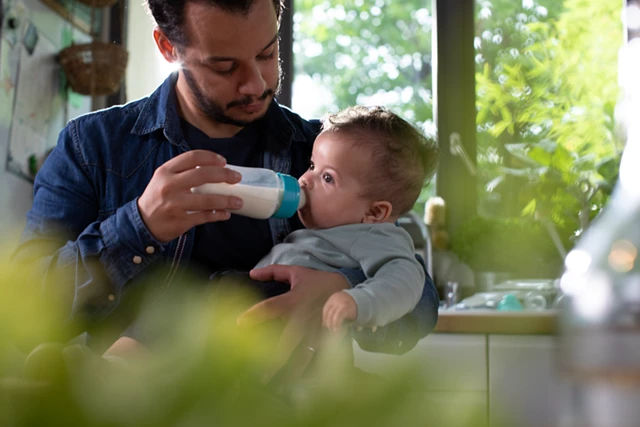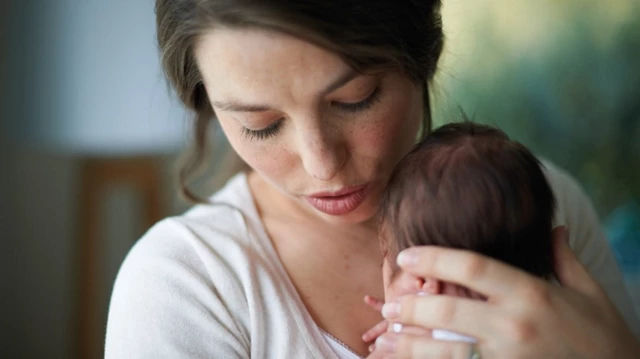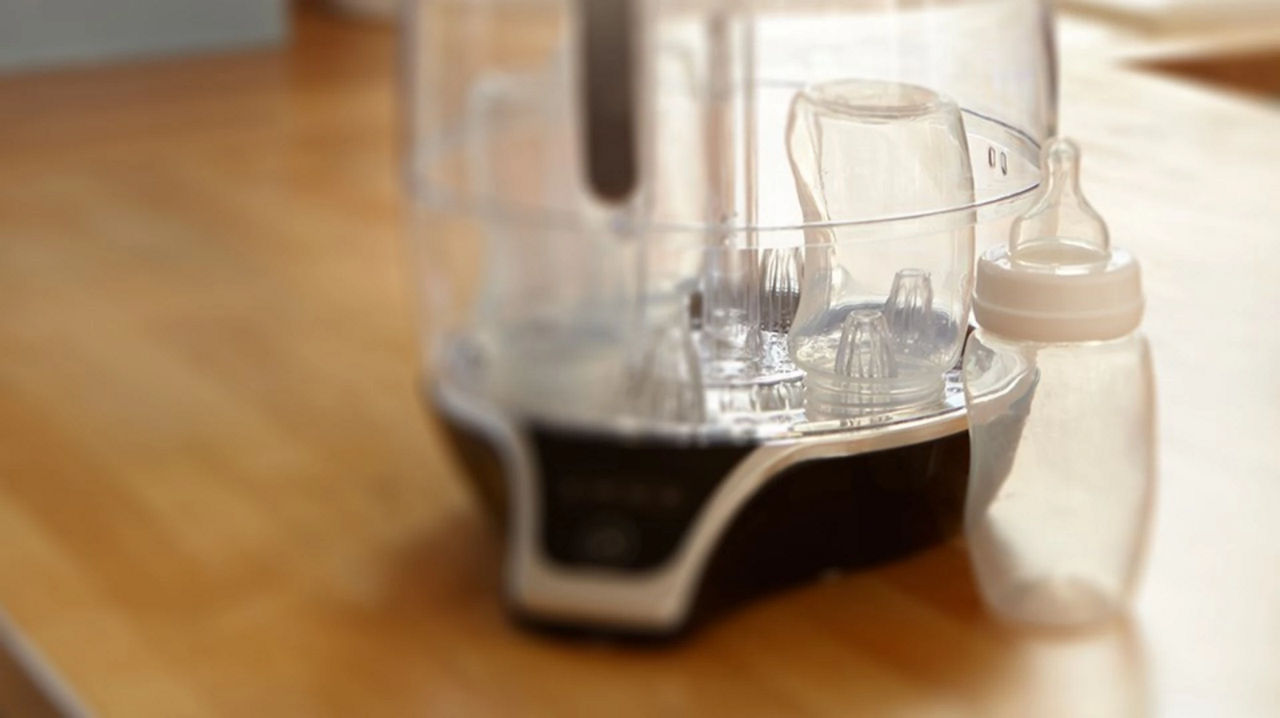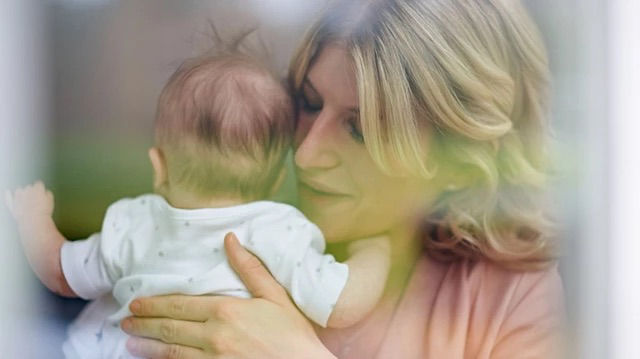Preparing a bottle-feed
Looking for top tips on how to prepare formula milk? We’ve got you covered..
From how to make formula milk to how to bottle feed a baby, discover our step-by-step guide to help you get started on your feeding.
Want more help and advice about formula feeding?

Step-by-step video guide to make up a bottle of formula for your baby
Before you know it, making your baby’s formula feeds will become second nature. Watch our simple, step-by-step guide to get you off to a flying start.
Essential equipment
If you’ve chosen to bottle-feed your baby with formula milk, there are a few essentials you’ll need, including1:
- Baby formula milk. You can choose ready-to-feed liquid or powdered formulations.
- Baby bottles. There are lots of different types and brands to choose from, including anti-colic and wide-neck bottles, as well as a more basic design. There’s nothing to suggest one bottle is better than another; it’s all about finding the one that suits your baby the best.
- Bottle teats. These are available with different flow rates - slow, medium and fast. A slow teat is the best option when bottle feeding a newborn, as this will prevent them from taking too much milk at once.
- A bottle brush and steriliser. Cleaning and sterilising your bottle-feeding equipment is very important, and this will help to avoid infections and tummy bugs.
Safety first! Read more about how to sterilise your baby’s bottles.
Step-by-step formula preparation
Before you start to prepare your baby’s bottle of formula, make sure that you’ve sterilised the feeding equipment you’re using and have thoroughly washed your hands.
Once you’ve done that, it’s time to follow the steps below2. Failure to follow the preparation instructions could make your baby ill:
- Add 1 litre of fresh tap water to the kettle and boil (avoid using water that’s been boiled before - the water you use should be freshly run from the tap).
- Let the water cool in the kettle for no longer than 30 minutes - this will ensure that it will have a temperature of at least 70C.
- Place your sterilised baby bottle on a clean surface and pour the required amount of water into it (always refer to the instructions on the back of the pack).
- Add the correct measure of baby milk formula powder to the water in the baby bottle. Always use the scoop and leveller provided; never press or heap the powder. Again, always follow the instructions on the back of the pack to ensure you’re using the correct amount.
- Put the sterilised teat and cap back on the baby bottle.
- Shake your baby’s bottle immediately. Do this vigorously for at least 10 seconds until the powder is dissolved.
- Check the temperature of your baby’s formula milk to ensure it’s not too hot for your baby to drink. If needed, hold the bottle under cold running water so that it can cool.
- Feed your baby straight away.
Bottle feeding techniques
Hunger cues, feeding positions and burping your baby - get in the know with bottle-feeding tips and techniques.
Spotting your baby’s hunger cues
If your baby starts3:
- Moving their eyes around and looking or ‘rooting’ for a bottle teat.
- Sucking on their fingers and hands (or anything they can get hold of, for that matter!)
- Getting restless and wriggly.
The likelihood is they’ve got a hungry tummy and are ready for their next feed.
How to hold your baby when bottle feeding
It’s a good idea to make yourself and your baby comfortable before you start their feed. Hold them close and support their head as you feed them in a semi-upright position - this will help them to breathe and swallow more easily as they suck from the bottle.
Be sure to burp your baby regularly both during and after their feed. Look at our guide to winding your baby for top tips and effective burping positions.
How to hold your baby’s bottle
When your baby is ready for their bottle, brush the teat gently against their lips, encouraging them to open their mouth and take it. Hold the bottle horizontally, tipped just a little, to allow the milk to flow steadily4.
Read more about paced feeding, which is a great way to give your baby more control over their feeds.
How often to feed your baby
How much milk your baby needs and how often they need to be fed depends on their age. If you’re bottle feeding a newborn, their tiny tummies will need to be fed little and often5. As your baby grows, they’ll probably settle into a more predictable pattern when it comes to when they feed and how much they take - just go at their pace and follow their lead.
Read more about how much and how often to feed your baby.
Safety and hygiene tips - how to make formula milk safely
Safety and hygiene are essential when it comes to bottle feeding a baby. Below, you’ll find plenty of guidance and tips for safely preparing your baby’s formula milk5, 2, 6:
- Always follow the manufacturer's instructions for the baby milk formula that you’re using.
- Never add extra scoops of formula powder to your baby’s bottle, as this can cause them to become dehydrated and constipated. Read more about constipation in babies.
- Never add extra water to your baby’s formula milk. Doing so can result in your baby not getting enough of the energy and nutrients they need.
- Don’t use bottled water to prepare formula feeds. It isn’t sterile and might contain too much sulphate and sodium.
- Formula milk should never be heated in the microwave - it can heat unevenly and burn your little one’s mouth.
- Don’t add anything to the milk in your baby’s bottle, for example, cereal or sugar.
How to store baby formula
You should always follow the storage instructions for the particular baby formula you’ve chosen to use.
If you’re using a powdered formulation, store in a dry, cool place once opened and use it before the use-by date stated on the pack, usually within 4 weeks of opening; powdered formula doesn’t need to be stored in the fridge7.
You’ll also need to store unopened bottles of ready-to-feed liquid formula in a dry, cool place, too. Once opened, you can keep them in the fridge (on the top shelf at the back) for up to 24 hours8.
Signs your baby formula has spoiled
Always follow the storage instructions on the pack. Check the formula for any changes to colour, smell and taste before feeding to your baby, as these could be signs that the formula has spoiled.
Last reviewed: June 2021
Reviewed by Oriana Hernandez Carrion
Related articles

Need some help?
You can get quick answers to common questions in our FAQs.
Alternatively, if you need help with general pregnancy or baby advice, or maybe on using or ordering our products - our expert team are always on hand to talk about feeding your baby.
- NHS Start for Life. Things you need for formula feeding [online]. Available at https://www.nhs.uk/start-for-life/baby/feeding-your-baby/bottle-feeding/how-to-make-up-a-feed/things-you-need-for-formula-feeding/. [Accessed February 2025]
- NHS. How to make up baby formula [online 2023]. Available at https://www.nhs.uk/conditions/baby/breastfeeding-and-bottle-feeding/bottle-feeding/making-up-baby-formula/. [Accessed March 2025]
- NHS Start for Life. Feeding on demand [online]. Available at https://www.nhs.uk/start-for-life/baby/feeding-your-baby/bottle-feeding/bottle-feeding-your-baby/feeding-on-demand/#:~:text=Signs%20of%20hunger&text=try%20to%20find%20something%20to,start%20wriggling%20and%20getting%20restless. [Accessed February 2025]
- NHS. Bottle feeding advice [online 2024]. Available at https://www.nhs.uk/conditions/baby/breastfeeding-and-bottle-feeding/bottle-feeding/advice/. [Accessed February 2025]
- NHS (2023). Formula milk: common questions [online] Available at https://www.nhs.uk/conditions/baby/breastfeeding-and-bottle-feeding/bottle-feeding/formula-milk-questions/ [Accessed February 2025]
- NHS. Sterilising baby bottles [online 2023]. Available at https://www.nhs.uk/conditions/baby/breastfeeding-and-bottle-feeding/bottle-feeding/sterilising-baby-bottles/. [Accessed February 2025]
- NHS Health Scotland. Formula feeding [online 2020]. Available at https://www.wihb.scot.nhs.uk/wp-content/uploads/2020/03/5523-__Formula-feeding-booklet-Jan2020-English.pdf. [Accessed February 2025]
- NHS Start for Life. How to use formula [online]. Available at https://www.nhs.uk/start-for-life/baby/feeding-your-baby/bottle-feeding/how-to-make-up-a-feed/how-to-use-formula/#:~:text=If%20you%20are%20using%20ready,no%20longer%20than%2024%20hours. [Accessed February 2025]





